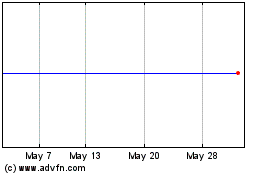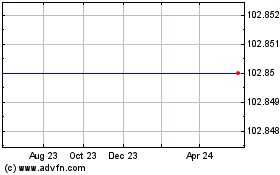Vaping Expected to Increase COPD Health and Economic Burden by 2050
September 10 2024 - 8:00AM
UK Regulatory
Vaping Expected to Increase COPD Health and Economic Burden by 2050
New ResMed-supported research presented at
ERS 2024 projects future Chronic Obstructive Pulmonary Disease
(COPD) burden in Western Europe, accounting for increased air
pollution, tobacco smoking, and vaping, with Non-Invasive
Ventilation (NIV) enhancing survival rates.
- 88.7 million new COPD hospitalizations projected across
Western Europe between 2019 - 2050
- Vaping projected to incur almost €30 billion additional
direct and indirect costs by 2050
- €4.9 trillion projected cumulative cost to support COPD lung
conditions by 2050
- 16% projected reduction in risk
of death after a severe exacerbation for COPD patients using home
NIV support
SAN DIEGO and VIENNA, Sept. 10, 2024 (GLOBE NEWSWIRE) -- ResMed
presented 18 supported studies at ERS 2024, including research that
projects vaping, smoking, and air pollution will substantially
increase the economic and public health burden of COPD in Western
Europe. Annual direct and indirect costs are projected to reach
over €170 billion by 2050, costing Western European economies over
€4.9 trillion cumulatively by 2050. Vaping alone is forecast to
require an additional €3.78 billion annually to support its impact
on medical care and societal costs.
COPD poses a significant health and economic burden, further
exacerbated by environmental and behavioral changes such as air
pollution and vaping. Previous modeling work has focused on
quantifying the burden of COPD across North America, accounting for
tobacco smoking and air pollution1. The ResMed-supported
research aimed to extend this US modeling by also accounting for
the effects of vaping on the COPD burden in Western
Europe2.
The results of this pertinent research were presented at ERS
2024 by Elroy Boers, PhD, Lead Health Research Scientist, ResMed.
The model projected that, in addition to smoking and air pollution,
vaping is going to have a notable economic and health impact on the
burden of COPD into 2050, both cumulatively and annually.
2050 outcomes describing the relative increase associated with
vaping (vs. the scenario without vaping) were concluded to be:
- Direct costs are projected to relatively increase by 0.5%
(cumulative) and 2.1% (annual) – representing a cumulative increase
of €10 billion.
- Indirect costs are projected to relatively increase by 0.7%
(cumulative) and 2.3% (annual) – representing a cumulative increase
of €20 billion.
- The number of exacerbations is estimated to relatively increase
by 0.3% or 1.6 million (cumulative) and 1.8% (annual)
- The number of hospitalizations is projected to increase by 0.2%
or 190,000 (cumulative) and 3.3% (annual).
“To avoid escalating costs to public finances, additional strain
on health services, and reduce loss of life from COPD, much greater
action is required. Public health and advocacy efforts targeting
known risk factors such as smoking, vaping, and ambient and
household air pollution may be critical to prevent this anticipated
burden,” said ResMed Chief Medical Officer Carlos M. Nunez,
M.D.
In a separate ResMed-supported study presented by Professor
Jean-Louis Pépin, Grenoble Alpes University, France, the role of
home non-invasive Ventilation (NIV) support in managing COPD was
explored. The study found that continued use of home NIV
significantly reduces risk of death from COPD flare-ups
(exacerbations), with a 16% reduction in mortality risk following
severe exacerbations and a 12% reduction for those without
exacerbations. The study involved nearly 50,000 adults with COPD
who were treated via home NIV. The multistate model analysis
estimated the impact of NIV continuation versus cessation on
transitions between three different disease states (without severe
exacerbation, severe exacerbation, and death).
“The positive impact of home NIV in reducing risk of death
offers some comfort for those millions of people already suffering
from COPD and those who will suffer in years to come. However,
proactive work now on the part of potential patients and their
loved ones to learn and recognize symptoms early, as well as
preventative steps to reduce risk factors, will go a long way
toward positively impacting hundreds of millions of lives
worldwide,” Nunez continued. “Education and meaningful action are
essential to curbing the number of people impacted by COPD and
life-threatening events caused by these conditions.”
Complete list of ResMed-supported studies presented at
ERS 2024:
- The modified Baveno classification for obstructive sleep apnoea
management
- Impact of home NIV on severe exacerbations and survival in
COPD: a French nationwide cohort study using multistate models
- Light, latitude and Epworth Sleepiness Scale in the European
Sleep Apnea database - a daring proposal
- The economic and health burden of COPD in Western Europe
through 2050: a scenario analysis based on two large data
sources
- Role of Partnership in PAP Therapy Adoption in Obstructive
Sleep Apnoea
- A negative effect by ATC N-class treatment in OSA patients with
concomitant psychiatric disease: an ESADA cohort study.
- Association of sleep-related hypoxia with survival in patients
with non-small cell lung cancer – the NEOSAS-GFPC study group
- Adaptive servo-ventilation (ASV) in patients with central or
complex sleep apnea and associated cardiovascular comorbidities:
the READ-ASV registry
- Effect of adaptive servo-ventilation on cardiac repolarization
in patients with myocardial infarction and sleep-disordered
breathing
- Effect of non-respiratory arousals on residual sleepiness in
CPAP-treated OSA patients
- The association between behavioural clusters and short-term PAP
usage in OSA
- PAP use in OSA patients with and without insomnia
- Usage of adaptive servo-ventilation (ASV): results from the
READ-ASV registry
- A scenario-based modelling study to project the future burden
of COPD in Western Europe accounting for air pollution, tobacco
smoking, and e-cigarette vaping
- Obstructive Sleep Apnoea and C-reactive protein levels: Data
from the ESADA
- Preserved ratio impaired spirometry and OSA may contribute to
cardio-metabolic complications: evidence from the ESADA cohort
- Comparisons of cardiovascular risk scores in patients with
obstructive sleep apnea - the European Sleep Apnea Database
(ESADA)
- Effect of CPAP on circulating levels of MPO and MMP-9 in adults
with coronary artery disease and obstructive sleep apnoea: the
RICCADSA randomized controlled trial
About ResMed
At ResMed (NYSE: RMD, ASX: RMD) we pioneer innovative solutions
that treat and keep people out of the hospital, empowering them to
live healthier, higher-quality lives. Our digital health
technologies and cloud-connected medical devices transform care for
people with sleep apnea, COPD, and other chronic diseases. Our
comprehensive out-of-hospital software platforms support the
professionals and caregivers who help people stay healthy in the
home or care setting of their choice. By enabling better care, we
improve quality of life, reduce the impact of chronic disease, and
lower costs for consumers and healthcare systems in more than 140
countries. To learn more, visit ResMed.com and follow
@ResMed.
For
Media
Emily
Yandle
ResMedUK@teamlewis.com
Julia
Moser
news@resmed.com
1 E. Boers, A. Allen, A.
Benjafield, M. Barrett, and A. Malhotra. The Economic and Health
Burden of COPD in North America: Forecasting Through 2050
(abstract). Am J Respir Crit Care Med2023;207:A3593.
2 E. Boers, A.
Allen, A. Benjafield, L.E. Crotty Alexander, A. Malhotra
and M. Barrett. A scenario-based modeling study to project the
future burden of COPD in Western Europe accounting for air
pollution, tobacco smoking, and e-cigarette vaping.
(abstract). ERS 2024.


Resmed (LSE:0KW4)
Historical Stock Chart
From Dec 2024 to Jan 2025

Resmed (LSE:0KW4)
Historical Stock Chart
From Jan 2024 to Jan 2025
